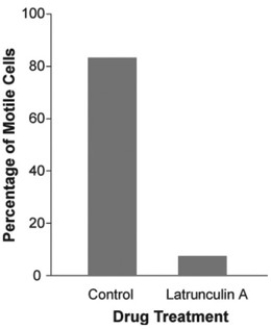Use the following information to answer the question(s) below.
The mechanism of cell crawling in protist species is not well defined. Pseudopodia extension involves interactions between actin and myosin (the same molecules that are involved in vertebrate muscle contraction) . However, prior to the study described below, no one had provided convincing data that actin and myosin were actually involved in cell crawling in protists. Anatomical studies had identified the cytoskeletal protein actin just below the surface of the cell membrane in several species of protist, but physiological studies had failed to show a functional link between actin, myosin, and cell crawling.
In a study by N. Poulsen et al. (Diatom gliding is the result of an actin-myosin motility system, Cell Motility and the Cytoskeleton 44 (1999) :23-22) , researchers tested whether motility in a particular species of diatom involves interactions between actin and myosin. 
-Refer to the study by Poulsen et al. and the accompanying figure. Latrunculin A is a reversible toxin that disrupts the formation of actin fibers. A culture of a particular species of diatom was treated with this toxin diluted in a buffer, while another culture was treated only with the buffer (no toxin; control) . The motility of cells in each culture was assessed by counting the number of cells that were moving during a defined period of time. Which of the following conclusions is reasonable based on the figure?
Definitions:
Chirality Center
An atom, typically carbon, in a molecule that has four different substituents and can exist in two enantiomeric forms, leading to different spatial configurations.
Stereocenter
An atom in a molecule that is bonded to four different groups, creating different spatial arrangements.
Enantiomer
Molecules that are mirror images of each other and cannot be superimposed onto each other, commonly found in chiral molecules.
Diastereomers
Non-mirror-image stereo isomers that have varying physical and chemical properties from each other.
Q6: Which of the following is a fitness
Q7: Use the following information to answer the
Q7: Cell differentiation always involves _.<br>A) the production
Q17: On the basis of their morphologies, how
Q18: Which piece of evidence supports the hypothesis
Q28: Identify the location of the disulfide bond
Q39: Use the following description to answer the
Q40: Sponges are most accurately described as _.<br>A)
Q44: In 2005, a spot that is 1
Q54: House finches were found only in western